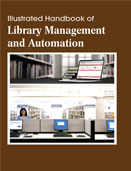Handbooks

Library is a fast growing entity in the Era of 21st Century. The ancient methods of maintaining it are no longer dynamic and efficient. For expeditious retrieval and dissemination of information and better service for the clientele, application of modern techniques has become absolutely indispensable. A properly computerized library will help its users with quick and prompt services. Library automation refers to mechanization of library housekeeping operations predominantly by computerization. Library automation or Integrated Library System (ILS) is an enterprise resource planning systems for a library, used to tracks items owned, order made, bills paid etc. This helps to keep the records of whole transactions of the books available in the library. A library management system (LMS) is used to track items owned, orders made, bills paid, and patrons who have borrowed. This book provides practical directions for replacing library automated systems. This book presents a new hierarchical heterogeneous of parallel computing model which is based on the method library as well as its management system
Library automation refers to the use of computer to automate the typical procedures of libraries such as cataloging and circulation. For centuries, Libraries have served communities around the world in assimilating and disseminating knowledge. Libraries have played a significant role in shaping communities of the world. The advent of computers half a century ago and the proliferation of the Internet in recent times have multiplied the order of magnitude many times over and made access to information faster and cheaper, creating a level playing field, limited only by access. The problem of access is fast disappearing with the telecom revolution of the last decade or so, bringing the world?s knowledge quickly and efficiently to every person. The world has not seen a bigger revolution than this. Traditional Libraries that host unique collections to serve a particular community or group must therefore ensure that their catalogs are available to their patrons on devices such as Smart Phones and Tablets that people use every day, else their very purpose of existence will not be served. Automation is also a way of preparing the collection to become sustainable with the ever-increasing shift to a technology-based society, in terms of information dissemination, paired with the ever-decreasing amount of funding for libraries. Automation will help libraries who begin to struggle and are forced to lay off staff. Switching to an automated system allows libraries to add on features when they become available in the future, instead of having to do a complete overhaul of their collections and cataloging methods Illustrated Handbook of Library Management and Automation presents the various methods of delivering automated information retrieval services as part of an integrated unit, how they work together and how they impact on each other. Emphasis is also placed on the evolution of new management structures in the Library to deal successfully with, and driven by, the new system. Currently, libraries find themselves confronted with a second computerization wave. The first wave took place during the seventies and turned manual back-room activities, such as acquiring, distribution and cataloguing, into computer-controlled activities. Essential in the computerization wave of the 90s is the deployment of computer networks: campus-wide networks at universities as well as national and international networks. These networks provide access to remote electronic information by means of library information systems. Furthermore, available electronic information is no longer limited to so called secondary information (catalogues, bibliographic databases). Also primary information has now become electronically available. Presently, we can refer to the electronic full-text versions of scientific journals. Electronic textbooks and readers enable us to consult information outside the library, i.e. at the professional and private work site of the library?s traditional customer.
The Illustrated Handbook of Library Management and Automation includes the growth of the use of networks and the internet in libraries. This book helps to understand the application of computer and telecommunications technology to bibliographic control, database access, resource sharing and other electronic communication or transmission for the purpose of improving and enhancing services to library users.